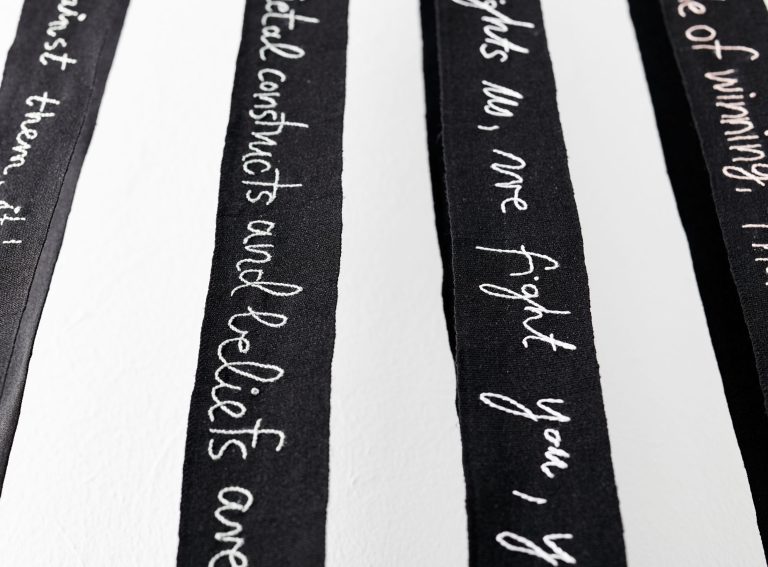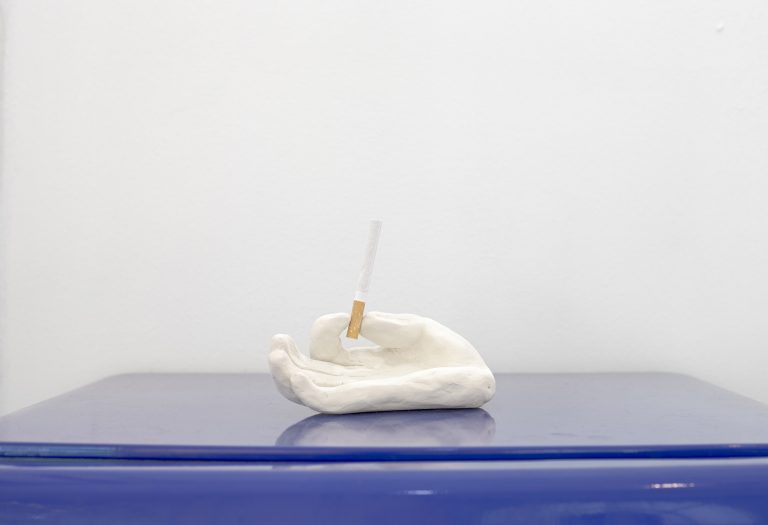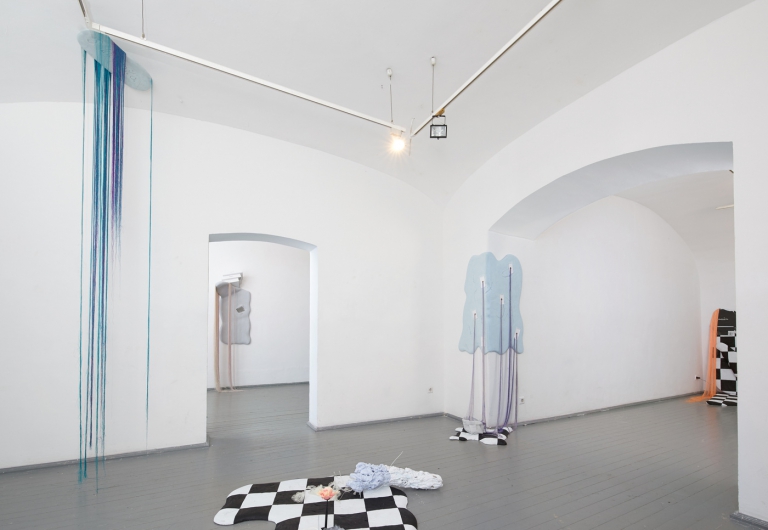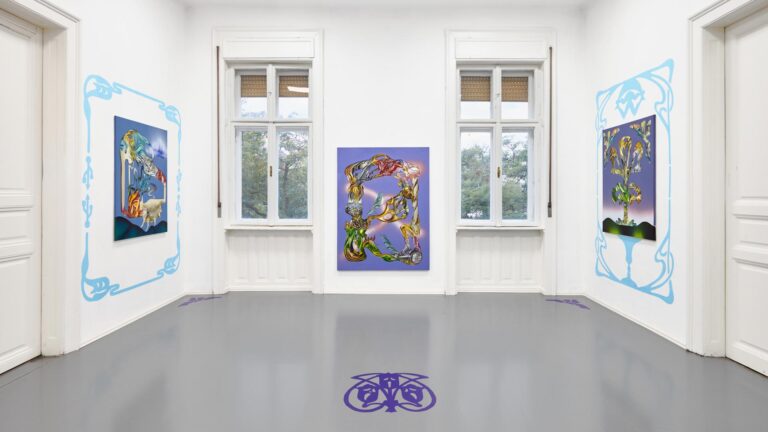Artist: Ádám Albert
Exhibition title: Dream of a Barn Owl
Curated by: Gábor Rieder
Venue: Kisterem, Budapest, Hungary
Date: March 1 – 31, 2017
Photography: all images copyright and courtesy of the artist and Kisterem, Budapest
Budapest’s Kisterem Gallery is proud to present the latest works by Ádám Albert in an exhibition titled Dream of a Barn Owl, which runs in parallel with – and is closely related to – his one-man show in Paks Picture Gallery, Melancholy of the Disconstructed Meaning.
Even a common barn owl (Tyto alba) can have a dream. Sweeping silently through the soft, warm darkness of a night-time motorway, it was suddenly blinded by a flood of light, cast by the fog lamps of an approaching truck. A flash, a loud thud, and it flails helplessly in mid-air. Some time later, now filled with fixing pins, it regains consciousness in a formaldehyde-filled container in a taxidermist’s studio. It didn’t even blink, only squinted with its jet black button eyes, peering from the middle of the uncannily white face-like patch on the front of its head. It holds its wings outstretched as though about to take off, to soar away into an alternative twentieth-century parallel history, in which events turned out somewhat differently, in which clever concrete (a cellular construction method), a Hungarian invention much acclaimed by Bauhaus architects, became a world-famous, modernist building material, even convincing Khrushchev to have it mass produced in his Soviet home-making factories, treating it as the Eastern Bloc’s retort to the utterly different and infinitely attractive dream kitchens in the garden cities of America. The barn owl, the common barn owl (Tyto alba), dreams of success and celebrity, flexing its wings even as twilight slowly comes around, while in the studio, the shadows of the anatomical plaster casts and other items lined up on the shelves grow longer and longer, the shelves themselves utter charming creaks, and the final rays of the sun, as it sinks behind the neighbouring houses, twinkle off the edges of the brightly coloured stone and glass tiles. Even an owl, a common barn owl (Tyto alba), can have a dream.
The narrative of Ádám Albert’s latest exhibition is related through the mouth of a stuffed and mounted barn owl that was found dead by the side of a road (Nightwatch of Anxiety #1, 2017), and it weaves together threads that are both historical and personal. Béla Sámsondi Kiss, the architectural engineer who invented “clever concrete” (a durable construction material in which concrete is poured into a plasterboard negative and then allowed to set), died in 1972, three years before the birth of Ádám Albert, the nephew of István Szövényi, who happened to be one of Sámsondi Kiss’s most faithful pupils. The engineer’s death came thirty years after his modernist invention was praised in the pages of the architectural magazine Híd, in an article written by the eminent former Bauhaus student Farkas Molnár. It was also just a few years after György Jovánovics, the emblematic sculptor of Hungary’s neo-avant-garde generation, first discovered the lyrical beauty (and pop-art appeal) in a solidified bag of plaster. In the late 1950s and early 1960s, when the Hungarian state embarked on a massive programme of building affordable, modern housing, Sámsondi Kiss’s “clever concrete” would easily have had the upper hand over the prefabricated panels that were actually used. There were even a few experiments carried out using the Hungarian invention, which would have been the perfect material for fulfilling the social mission embodied by modernism. Instead, the technique was passed on by only a handful of masons, although it also helped to sow the seeds of progressive art and architecture (the architect Péter Janesch presented the work of Béla Sámsondi Kiss to his international colleagues at the Architecture Biennial in 2004). István Szövényi, Sámsondi Kiss’s student, worked for the industrial design company IPARTERV, whose exhibition hall “gave birth to” the Hungarian neo-avant-garde; later he worked for the Budapest Association of the Construction Materials Industry, whose many innovations included Miklós Erdély’s invention of mural photo-mosaics. The studio apartment of Erdély and Jovánovics was designed by István Szövényi, and he thus unwittingly left his mark on the history of contemporary Hungarian art.
Ádám Albert delved into this wide-ranging cultural, historical and personal subject matter when he began to conduct his own experiments into what could be done with “clever concrete”, transplanting this modernist invention into the fertile grounds of an even broader technological-cum-handicraft tradition. Using the technique of “clever concrete” he recently produced an enormous installation in Paks Picture Gallery (Library of Craftsmanships, 2017), a miniaturised mock-up of which appears in the Kisterem Gallery, standing on one of the items of pseudo furniture constructed of metal frames supporting pairs of plasterboard negatives (Home Sweet Home, 2017). The interior-like ensemble is complemented by a carved marble, faux modernist, broken bookshelf (Flat-Packed Landscape (Vanishing point), 2016), as well as ambrotypes (collodion positives) of an anatomical muscular model (Plaster Modulor, 2016) and a copper laurel wreath (Victory, 2016). In the second room, Ádám Albert has constructed a “folding screen” out of plaster panels, with part of its surface decorated with a pyramidal pattern (Boudoir, 2017). Some of the 60 x 60 cm “clever concrete” modules used to make the screen have instead been hung on the wall, transubstantiated into “easel works” titled From the series of Non-Existing Mixed Technics (2016–2017). On the walls around the screen, iron structures fitted with colourful stone insets or abstract leaded glass windows bring the exhibition into thematic unity; each of these frames also features an ambrotype inset: one is of a plaster bust facing away from the viewer (SKB, 2017), another shows a study of a distorted wall (Twisted wall, 2017), while the third is a portrait of the stuffed and mounted barn owl (Nightwatch of Anxiety #2, 2017). The closing item, the actual stuffed owl preparing to take flight (Nightwatch of Anxiety #1, 2017), is the metaphorical narrator of the exhibition, observing the diverse set of works from a high vantage point, fully aware that it is through weaving together different techniques, inventions and means of expression, and through embedding them in history, that meaning comes to life, mutates and expires.
– Gábor Rieder
Ádám Albert, Home Sweet Home, 2017, installation (iron, plaster, plans, plywood, cable, lamp, glass), variable dimensions
Ádám Albert, Home Sweet Home, 2017, installation (iron, plaster, plans, plywood, cable, lamp, glass), variable dimensions
Ádám Albert, Home Sweet Home, 2017, installation (iron, plaster, plans, plywood, cable, lamp, glass), variable dimensions
Ádám Albert, Home Sweet Home, 2017, installation (iron, plaster, plans, plywood, cable, lamp, glass), variable dimensions
Ádám Albert, Home Sweet Home, 2017, installation (iron, plaster, plans, plywood, cable, lamp, glass), variable dimensions
Ádám Albert, Home Sweet Home, 2017, installation (iron, plaster, plans, plywood, cable, lamp, glass), variable dimensions
Ádám Albert, Plaster Modulor, 2016, ambrotypes (collodion positive), on glass, 30×24 cm; Victory, 2016, ambrotypes (collodion positive), on glass, 30×24 cm
Ádám Albert, Flatpack landscape (Vanishing point), 2016, Welded iron, 127 x 21 cm, Marble incrustation (3 pieces), 19 cm x 110 cm 2 cm
Ádám Albert, SKB, 2017, 30×24 cm, ambrotype (collodion positive), 29 x 50 cm, glass, iron, 128 x 81 x 13 cm
Ádám Albert, Twisted wall, 2017, 24×30 cm, ambrotype (collodion positives), 29 x 50 cm, stained glass, iron, 70 x 117,5 x 13 cm
Ádám Albert, Nightwatch of Anxiety #2, 2017, 24×30 cm, ambrotype (collodion positive), 50 x 29 cm, quartzite , iron, 80 x 97,5 x 13 cm
Ádám Albert, Nightwatch of Anxiety #1, 2017, stuffed and mounted barn owl, ca. 20 x 30 x 20 cm
Ádám Albert, Nightwatch of Anxiety #1, 2017, stuffed and mounted barn owl, ca. 20 x 30 x 20 cm
Ádám Albert, Boudoir, 2017, cellular construction, gypsum, iron, plastic, foam, 180 x 127 cm
Ádám Albert, Boudoir, 2017, cellular construction, gypsum, iron, plastic, foam, 180 x 127 cm
Ádám Albert, Boudoir, 2017, cellular construction, gypsum, iron, plastic, foam, 180 x 127 cm
Ádám Albert, Boudoir, 2017, cellular construction, gypsum, iron, plastic, foam, 180 x 127 cm
Ádám Albert, Boudoir, 2017, cellular construction, gypsum, iron, plastic, foam, 180 x 127 cm
Ádám Albert, Boudoir, 2017, cellular construction, gypsum, iron, plastic, foam, 180 x 127 cm
Ádám Albert, From the series of Non-Existing Mixed Technics (2016–2017), 2017, cellular construction, gypsum, concrete, 60 x 60 x 7 cm






























